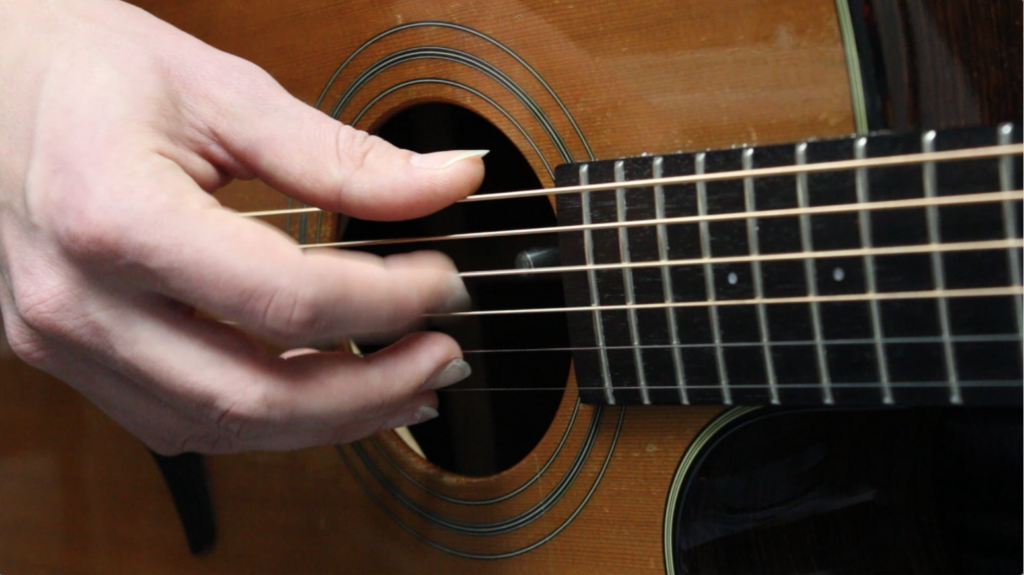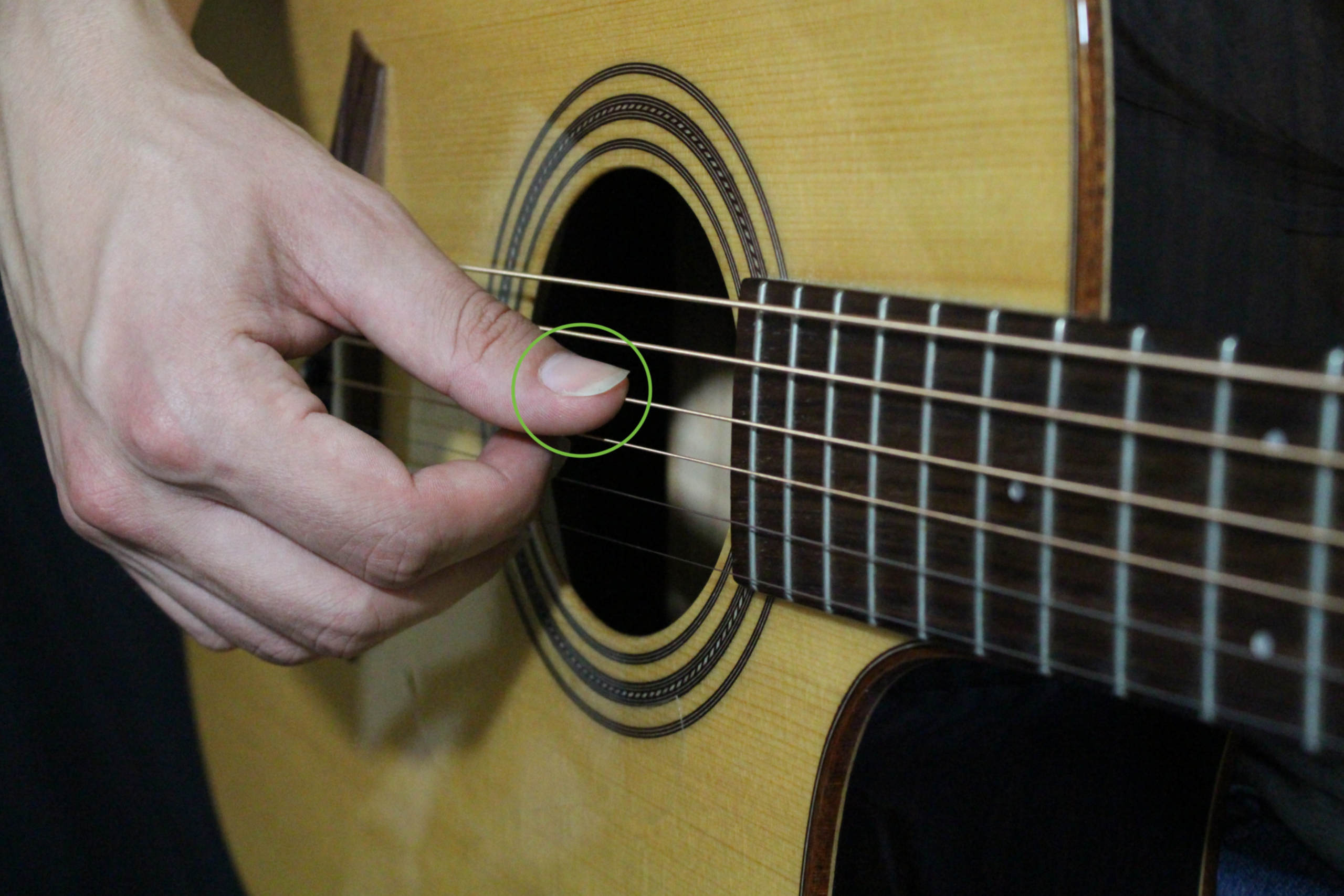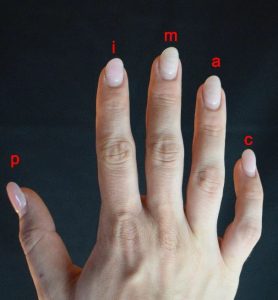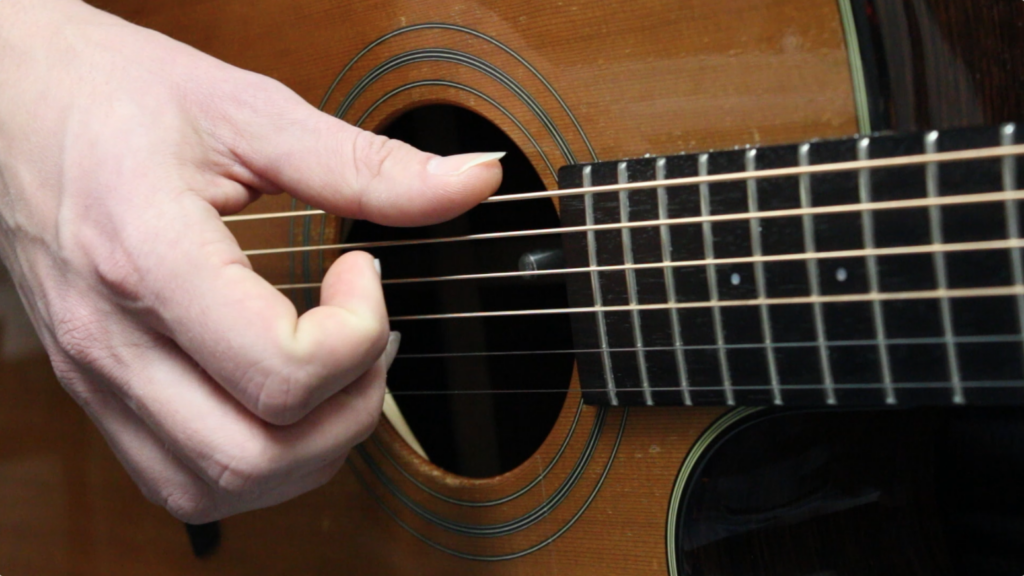It’s essential to have the correct RH technique in order to improve in your playing. First we must focus on the right hand and the proper technique associated with it.
Having proper technique will make playing much easier and allow you to play more challenging repertoire and exercises.
Fingers and Strings
Thumb should be on the sixth, fifth, and fourth strings while the index middle ring will be on the third, second and first strings.
P = 6, 5, 4
I = 3
M = 2
A = 1
Right hand positioning
The right hand should be hovering over the sound hole in the middle. You can also place it back slightly as well for a different timbre. Make sure the right hand is relaxed while hanging over the strings.

Attack motion
The attack should be a motion of the fingers coming in towards the palm. Prevent yourself from plucking up, or a clawing attack, which will cause the strings to be bright and thin.
Here is a video on beginner finger picking patterns I recommend:
Practice this with your own songs, or solely to work on your technique in order to improve your playing.
Learn more about technique through our FREE Fingerstyle Workbook!
FOLLOW US ON
Get our FREE Fingerstyle Workbook!
RELATED BLOG POSTS
Guitar Inversions
Whether you’re a beginner eager to expand your chord vocabulary or an advanced player looking to add depth and complexity to your arrangements, mastering inversions can open up a world of creative possibilities on the fretboard.
Guitar inversions involve rearranging the notes of a chord so that a different note becomes the lowest pitch. This results in a new voicing of the chord, often with a richer and more harmonically interesting sound. Inversions are commonly used in various styles of music, from classical to jazz to pop, to create smooth voice leading and add color to chord progressions.
To get started with guitar inversions, it’s essential to understand the basic principles of chord construction and harmony. Familiarize yourself with the notes of each chord and experiment with different fingerings and voicings on the fretboard.
Once you have a solid understanding of chord voicings, start practicing inversions by systematically rearranging the notes of basic triads and seventh chords. Begin with simple chord shapes like C major and G major, and explore different inversions by moving the bass note to different strings and frets.
As you become more comfortable with inversions, challenge yourself to incorporate them into your playing in musical contexts. Experiment with using inversions to create smooth chord transitions and interesting harmonic progressions in your compositions and arrangements.
In addition to practicing inversions on your own, try analyzing the chord progressions of your favorite songs to identify inversions used by other guitarists. This will help you develop an ear for recognizing inversions in music and inspire you to incorporate them into your own playing.
In conclusion, mastering guitar inversions is a valuable skill that can greatly enhance your playing and musical creativity. By exploring different voicings and harmonies on the fretboard, you can create music that is rich, expressive, and truly captivating. So grab your guitar and start experimenting with inversions today!
Guitar Chord Extensions
Chord extensions are additional notes added to basic triads to create richer, more complex harmonies. They include intervals like 7ths, 9ths, 11ths, and 13ths, which can add a whole new dimension to your chord progressions.
To get started with chord extensions, it’s essential to understand basic music theory concepts like intervals and chord construction. Familiarize yourself with the major and minor scales, as well as the corresponding chords derived from each scale degree.
Once you have a solid foundation in music theory, start experimenting with adding extensions to your chord progressions. Begin by adding simple extensions like 7ths and 9ths to basic major and minor chords, and listen to how they alter the sound and mood of the progression.
As you become more comfortable with chord extensions, challenge yourself to incorporate more complex voicings and alterations into your playing. Experiment with different fingerings and inversions to find the voicings that best suit your musical style.
In addition to practicing chord extensions in isolation, try applying them to real-world musical situations. Play along with your favorite songs and try to identify the chord extensions used in the music. This will help you develop an ear for recognizing and incorporating chord extensions into your own playing.
In conclusion, mastering chord extensions is a valuable skill that will greatly enhance your guitar playing. By adding color and depth to your chord progressions, you can create music that is rich, expressive, and truly captivating. So grab your guitar and start exploring the world of chord extensions today!
Guitar Travis Picking
Named after the legendary guitarist Merle Travis, this fingerstyle technique has become a cornerstone of acoustic guitar playing, cherished for its intricate melodies and driving rhythms.
Travis picking involves alternating the bass notes with the thumb while simultaneously picking out melodies and chords with the fingers. It creates a rich and dynamic sound that’s perfect for accompanying vocals or playing solo arrangements.
To master Travis picking, start by practicing basic fingerpicking patterns using a simple chord progression. Focus on maintaining a steady rhythm with your thumb while adding melody notes with your fingers. Gradually increase the complexity of the patterns as you become more comfortable.
One of the hallmarks of Travis picking is its versatility. Whether you’re playing folk, blues, country, or rock, Travis picking can add depth and texture to your playing. Experiment with different chord voicings, melodies, and rhythms to create your own unique sound.
In addition to practicing traditional Travis picking patterns, don’t be afraid to incorporate your own variations and improvisations. Experiment with different fingerings, dynamics, and techniques to add your own personal touch to the music.
In conclusion, mastering Travis picking is a rewarding journey that will greatly enhance your guitar playing. By honing your technique and exploring the endless possibilities of this timeless technique, you’ll unlock a world of musical expression on the guitar. So grab your guitar and start picking away!





0 Comments